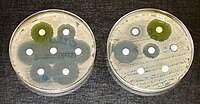
Photo from wikipedia
World Health Organizations launched a global action plan on antimicrobial resistance since 2015. Along with other objectives, the plan was aimed to strengthen knowledge of the spread of antimicrobial resistance… Click to show full abstract
World Health Organizations launched a global action plan on antimicrobial resistance since 2015. Along with other objectives, the plan was aimed to strengthen knowledge of the spread of antimicrobial resistance through surveillance and research. Given their high bacterial densities and that they receive antibiotics, metals, and other selective agents, wastewater systems are a logical hotspot for antibiotic resistance surveillance. The current study reports on the result of antibiotic resistance surveillance conducted in selected wastewater systems of Eastern Ethiopia from Feb. 2018 to Oct. 2019. We monitored three wastewater systems in Eastern Ethiopia, such as the activated sludge system of Dire Dawa University, waste stabilization pond of Haramaya University, and a septic tank of Hiwot Fana Specialized University Hospital for 18 months period. We collected 66 wastewater samples from 11 sampling locations and isolated 722 bacteria using selective culture media and biochemical tests. We tested their antibiotic susceptibility using the standard Kirby-Bauer disk diffusion method on the surface of the Mueller-Hinton agar and interpreted the result according to EUCAST guidelines. The result shows the highest percentage of resistance for ampicillin among isolates of hospital wastewater effluent which is 36 (94.7%), 33 (91.7%), and 32 (88.9%) for E. coli, E. faecalis, and E. faecium, respectively. A lower rate of resistance was seen for gentamicin among isolates of activated sludge wastewater treatment system which is 10 (16.4%), 8 (13.3%), 11 (18.9%), and 12 (20.3%) for E. coli, E. faecalis, E. faecium, and P. aeruginosa, respectively. Hospital wastewater exhibited higher resistance than the other two wastewater systems. The Multiple Antibiotic Resistance Index (MARI) has significantly increased in the wastewater's course treatment process, showing the proliferation of resistance in the wastewater treatment system.
Journal Title: Journal of Environmental and Public Health
Year Published: 2020
Link to full text (if available)
Share on Social Media: Sign Up to like & get
recommendations!